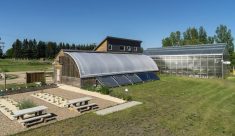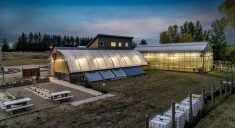Editor’s note: This is part 3 in our series exploring the complex factors behind rural depopulation in Manitoba, why it matters, the solutions that have been tried and what keeps young people in small communities. Read parts one and two, here.
The Rural STEP program that employed Margie Brincheski as a teenager helped get her into farming. Love kept her there.
Read Also

Journal pulls long-cited glyphosate study for ethics violations
The journal Regulatory Toxicology and Pharmacology has retracted a 2000 Monsanto-linked glyphosate review, drawing new scrutiny as Bayer faces mounting legal pressure.
Brincheski, the daughter of Scottish immigrants, grew up in the hydro town of Point du Bois, northeast of Winnipeg in Manitoba’s lake country. Summer job options for local teens were limited to Manitoba Hydro, the company store or the post office.
Then came the Rural STEP program, a provincially run temporary employment program geared toward rural teens. It was introduced as part of wider efforts to slow rural depopulation and had the ultimate goal of keeping more young people in their communities.
Through the program, work crews of local youth did construction and other grunt work in their home areas and local farms, overseen by post-secondary students.
It was Brincheski’s first job.
Her crew was put to work painting barns on dairy, chicken and beef farms in the Lac du Bonnet area. And during the experience, she recalls, she thought, “I would love to live on a farm.”
Why it matters: Rural communities have been looking to bolster their populations and vibrancy for decades, but what programs have made a dent in the problem?
The thought would become a self-fulfilling prophecy.
As well as her first work experience, her Rural STEP summer was also her first time away from home and, without a car, Brincheski boarded in Lac du Bonnet. There, she met and had a brief romance with a farmer’s son.
The two reconnected years later, both having moved to Winnipeg, and he eventually became her husband. He had already returned to the family farm in the early 1980s, Brincheski recalled. Once they were married, she joined him.
Today, her husband and youngest son farm together. Her daughter and two older sons have moved away.
“We’re great at exporting our youth,” she said.
The Rural STEP program gave Brincheski what she describes as a good summer job and a positive experience. But in a common refrain heard from many former STEP students, it was just a job. Despite the program’s mandate and goals, most participants finished their employment and later moved away for school or to find work elsewhere.
Stemming the flow
The STEP program was part of the Schreyer government’s Stay Option, in which the province pumped investment into rural communities in hopes that migration from farm to city would slow.
The concern was financial. Manitoba was a highly agricultural province, but previously vibrant agricultural communities were losing people in the years and decades leading up to the 1970s.
The programs, and efforts like them, came up against strong economic and social forces.
As of the 2021 census, the number of Manitoba farms had dropped by more than half compared to 1968, while the remaining farms were much bigger. Today, a smaller proportion of Manitobans live in rural areas, despite gross population growth in some rural regions.

Are people actually leaving?
The latest census data shows that, between 2016 and 2021, the rural population of Manitoba shrunk by 1.7 per cent. It also shrunk between the 2011 and 2016 censuses.
The annual demographic estimates from Statistics Canada, however, are sunnier in outlook. Estimates for 2021-22, the most recent information available, suggests the province’s rural population grew by nearly 2,300 people.
Looking deeper at those estimates, StatCan suggests that growth had a lot to do with immigration. Natural increases sat at 1,375 people, while international immigration brought a net 2,112 people to rural areas, and an estimated 237 people moved to rural Manitoba from somewhere else in the province.
On the other side, rural Manitoba lost 1,439 people who left for another province.
Since 2001, a substantial number of people between ages 20 and 24 have left rural Manitoba. Of those, a steady stream are bound for other provinces, although the majority move internally, to a city.
That trend has slowed over time. In 2010, a net 716 young adults moved from the country to urban Manitoba. In 2019, only 394 left for urban life, and even fewer moved during the pandemic.
In the 25-29 age group, it’s going the other way. The number of people moving from urban to rural areas with the province has been trending upward since 2011.
Seeding knowledge (and a work force)
The agriculture industry has struggled for years with a dwindling labour pool. In 2017, 1,447 agricultural jobs went unfilled in Manitoba, according to the Canadian Agricultural Human Resources Council. In 2020, the council predicted that, by 2029, the province would be short 5,330 agricultural workers.
The bids to address that gap range from investment into post-secondary programs, such as new options and industry investment at Brandon’s Assiniboine Community College, to programs centred on a much younger demographic.
Several producer groups have put their support behind Agriculture in the Classroom, an organization that provides resources to schools to teach students about agriculture and food.
The mandated Manitoba education curriculum has little focus on agriculture or food sources, said Katharine Cherewyk, executive director of Agriculture in the Classroom Manitoba (AITC-M).
In Grade 10, she noted, there’s a short unit called “food from the land,” but if teachers have little knowledge of agriculture themselves, they may show a Netflix documentary like “Food Inc.” to fill the requirement.
That documentary is “an unflattering look inside America’s corporate controlled food industry,” according its listing on the Internet Movie Database, a film website.
AITC-M’s goal is to tell a more nuanced, local story of agriculture and food. For younger students, it’s resources teach the fundamentals of how food is grown, that it grows all around us, and “here are some people in your community that help grow it, drive it around, process it,” Cherewyk said.
Middle years students might look at food issues like nutrition and may talk about career interests. High school resources connect students with careers in agriculture, which might span anything from accounting to agribusiness, and looks past the role of primary producer.
If kids still aren’t interested, Cherewyk said, at least they will know enough about where their food comes from and how it affects their communities to make informed choices at the voting booth or to advocate for people who work in agriculture.
AITC-M doesn’t have statistics on how many students within its reach enter agricultural jobs, but Cherewyk said assessments show greater agricultural interest among students after they’ve gone through AITC-M materials.
Rural coding clubs
While communities like the Point du Bois of Brincheski’s youth lacked industry, many rural communities today also lack connectivity.
“Research has demonstrated that rural communities acutely experience the digital divide,” wrote social researchers Wayne Kelly, Brian McGrath and Danielle Hubbard in a 2022 paper.
Services are “typically slower and inferior in quality, and costing substantially more compared with urban centres,” they wrote. That is compounded by the need for rural citizens, governments and industry “to develop skills and motivations to use technologies, not merely possess them.”
Kelly, the director of Brandon University’s Rural Development Institute, said the connectivity issue was apparent when he conducted focus groups and interviews.
Initially, he was concerned with the challenges of engaging youth in community decision making. As he spoke with young people, he discovered they were proficient with technology use for school, entertainment, socializing and gaming, but had less capacity in the deeper digital skills needed for community digital projects.
Kelly shifted his focus to building digital skills and awareness of digital tech among youth.
This led to establishment of coding clubs, first in Brandon, then in other western Manitoba communities of Glenboro and Neepawa. The initiative lasted 14 months before COVID-19 threw the brakes.
While in operation, the clubs were held at community libraries, which required organizers to secure enough laptops to accommodate the number of participants. A local government institution donated unused laptops and a local non-profit helped update them.
Kelly, who has some coding background, often led the activities, alongside librarians who had little to no coding experience. They used the “CoderDojo” model, a template for volunteer-led computer clubs for kids. Students can learn to code, build a website or create an app or game.
“Dojos are a space for kids and teens to explore technology in an informal, creative, safe and social environment,” CoderDojo’s website says.
Club leaders would give kids challenges, such as making a Halloween-themed game, and students would work at their own pace. Participants also learned about sensor technology, and one of the clubs partnered with a technology company to see how these tools could be applied in the real world, including a farm setting.
The clubs were social by design, flouting what Kelly called a stigma of the coder being a loner. The CoderDojo model has an unofficial rule that users should ask peers for help before asking a club leader. As a result, some kids later reported the club was their main social and skill-building extracurricular activity.
In total, 53 students participated across the three locations.
The researchers concluded that rural libraries can successfully deliver digital skill-building opportunities for local youth, and Kelly reported that participating libraries had begun new coding classes once pandemic restrictions allowed.
Rural Change Makers
Another factor affecting retention of young people is a sense of belonging, engagement and connection, according to the Rural Ontario Institute. These advantages are tough for young, passionate people to develop on their own, said executive director Ellen Sinclair, so the Rural Change Makers program was created.
The 12-month program helps young people develop skills needed for community development and put them into action with the guidance of coaches and mentors.
When the Co-operator spoke with Sinclair in late summer 2023, a new program cohort had just begun. Participants were slated to start with personal development and skills training covering fundraising, financial literacy, project management, cross-cultural understanding and Indigenous governance.
Each student was then expected to develop their own community development path, including consultation to discern local priorities. They could create their own project or work with a local partner.
For instance, Sinclair said, the Rural Ontario Institute developed a partnership with Opiikapawiin Services LP, a company made up of 24 First Nations in northern Ontario. The firm also administers projects and programs for First Nations-led utility company Watynikaneyap Power.
The power project came about because many First Nations communities relied on expensive diesel-powered generators for electricity, said Sinclair. Those generators were at maximum capacity, limiting the communities’ ability to build needed housing.
The partner First Nations came together to connect communities to the power grid. Most recently, Kasabonika Lake First Nation, about 600 kilometres north of Thunder Bay, was hooked up, according to an Oct. 14, 2023, news release.
Rural Change Makers connected with Opiikapawiin to find young people who wanted to eventually step into governance of the ongoing power project or address resource needs in the communities that now have reliable power.
Past program alumni addressed issues like rural homelessness, literacy and agriculture policy planning. They’ve led businesses and farms, become lawyers and researchers or run for local office, says the institute’s website.
They’re also more likely to stay close to home. In a 2022 stewardship report, the institute reported that 72 per cent of participants said they were likely to stay, work and live in their local community after completing the program. That was up from 45 per cent before the program.
Ninety-one per cent said they had a sense of belonging in their communities and believed they could make a difference.
This series will continue in the Jan. 18 edition of the Manitoba Co-operator.
















